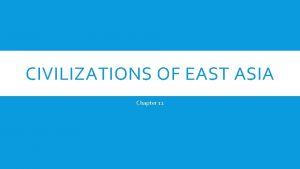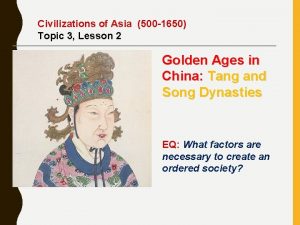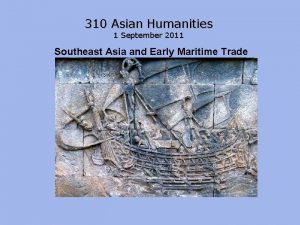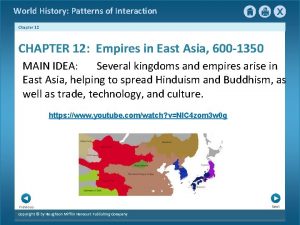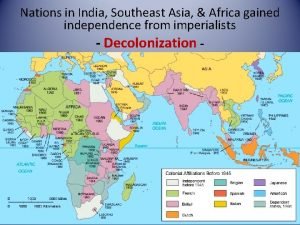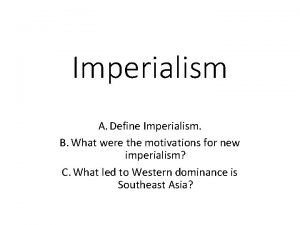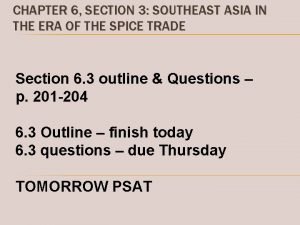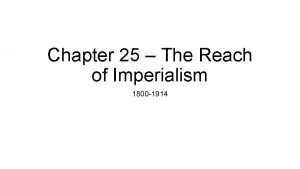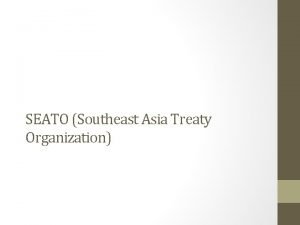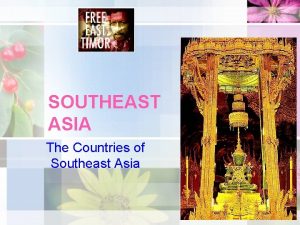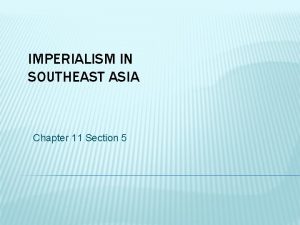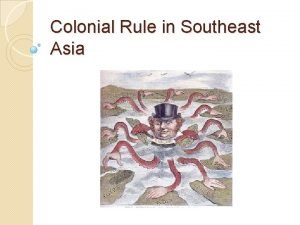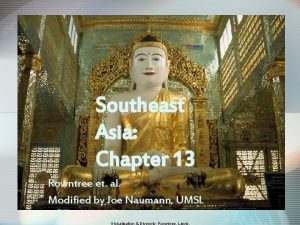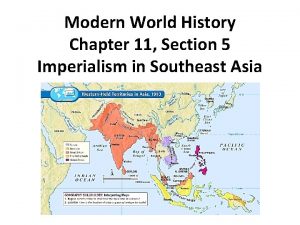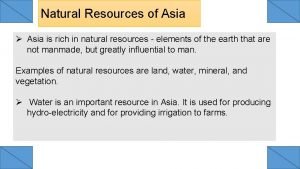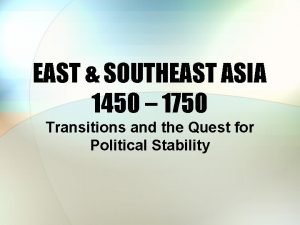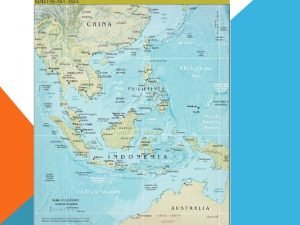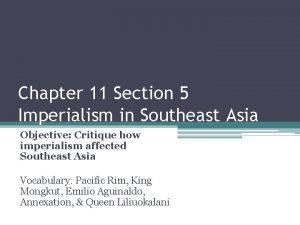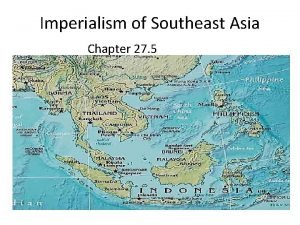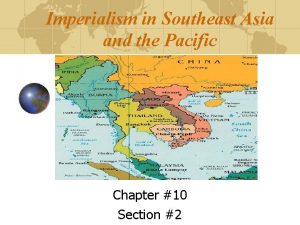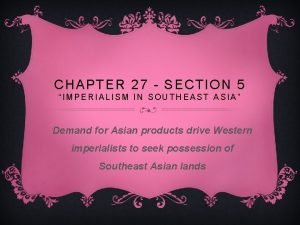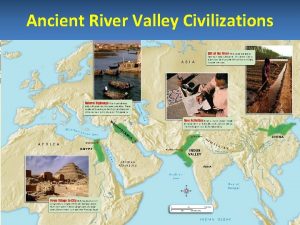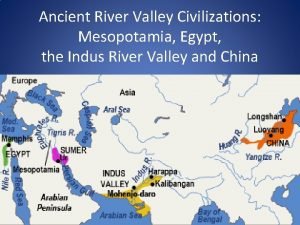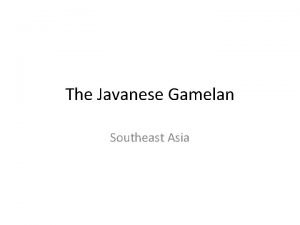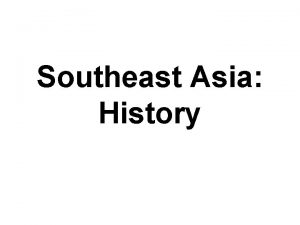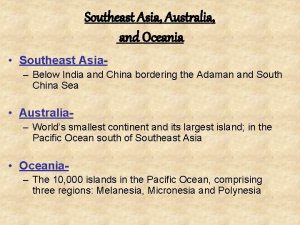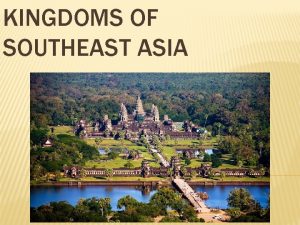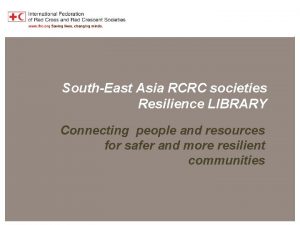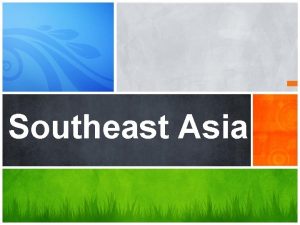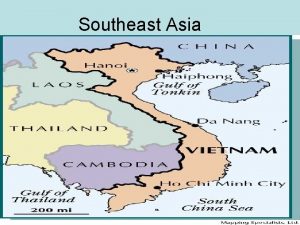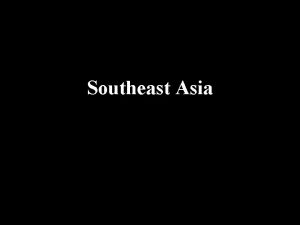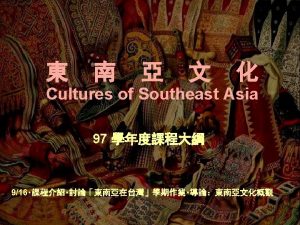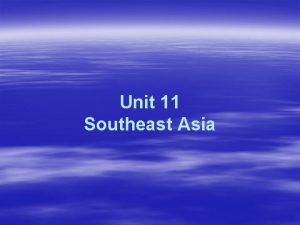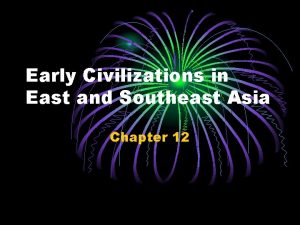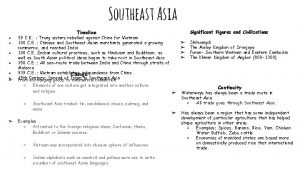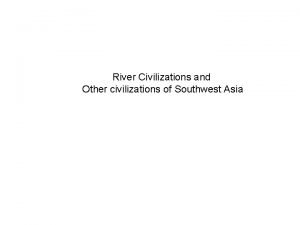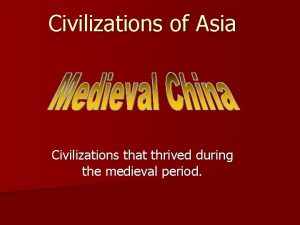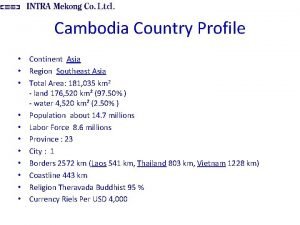C 11 4 Civilizations of Southeast Asia Main
































- Slides: 32

C 11. 4 - Civilizations of Southeast Asia Main Idea The early civilizations of Southeast Asia were influenced by geography and the cultures of India and China Objectives • What factors influenced early civilizations in the region of Southeast Asia? • What early kingdoms and empires developed in Southeast Asia?

I. Influences on Southeast Asia India and China shaped development; geography and trade also important

I. Influences on Southeast Asia • SE Asia divided in two parts—mainland SE Asia and island SE Asia • Mainland: modern nations of Cambodia, Laos, Myanmar, Thailand, Vietnam, part of Malaysia • Island: Rest of Malaysia, Brunei, East Timor, Indonesia, Philippines, Singapore


A. Geography • Valleys, river deltas home to farming civilizations • Mountains in between limited contact • Islands surrounded by seas and straits; provided sources of food, travel, trade routes


B. Trade • Two important trade routes between India and China: Strait of Malacca, Sunda Strait • Control of these brought wealth, power

B. Trade • Monsoons, or seasonal winds, shaped trade • Winds blow northeast in summer, southwest in winter

B. Trade • Ships relied on monsoons to sail from place to place; had to wait in port until winds shifted to resume voyage • Many Southeast Asian port cities became important economic centers

B. Trade • By AD 100 s, Indian merchants had begun prosperous sea trade with SE Asia • Trade routes through Central Asia became more dangerous after fall of Han dynasty in AD 220

B. Trade • Seaborne trade between China, India increased • Traders passed through Southeast Asia; exchanged goods for local products

C. India and China • Indian influence spread through trade and missionaries - Hinduism, Buddhism, Islam • Many kingdoms adopted the religions, built temples in Indian style

C. India and China • Ideas on writing, science, government, etc. spread to SE Asia • Ancient Indian language, Sanskrit, came into wide use

C. India and China • Chinese influence spread by conquest, trade, migration • China controlled northern Vietnam at different times, strongly influenced the region

II. Early Kingdoms and Empires • Early kingdoms of SE Asia blended their cultures with influences from India and China to form unique societies

A. The Pagan Kingdom • AD 800 s, Burmans established kingdom of Pagan in Irrawaddy River valley • Anawrahta ruled 1044 to 1077, united much of what is now Myanmar • Pagan became center of Buddhist learning

A. The Pagan Kingdom Irrawaddy River valley Buddhist Stupas (shrines)

A. The Pagan Kingdom • Late 1200 s – Mongols demanded tribute but Pagan refused • Mongols crushed Pagan’s army and the king fled • The king was killed by his son, who paid the tribute but Pagan lost it’s power

B. The Khmer Empire • Khmer empire arose southeast of Pagan (modern Cambodia) • Early 800 s - Khmer conquered neighboring kingdoms, build great empire • Reached height between 850 and 1250, controlled much of SE Asia mainland • Grew prosperous from rice farming

B. The Khmer Empire

B. The Khmer Empire • Khmer Empire adopted Hindu, Buddhist beliefs • Capital city, Angkor, symbolized shape of Hindu universe • Built temple complexes at Angkor Wat • Cost of building projects and invaders caused the empire’s decline

Angkor Wat

C. Trading Kingdoms • Several kingdoms developed on islands of SE Asia • 750 to 850 - Kingdom of Sailendra on Java • 600 s to 1200 s - Srivijaya empire on Sumatra • Controlled sea trade through Malacca and Sunda straits

C. Trading Kingdoms

D. Vietnam • Vietnam strongly influenced by China • 111 BC - Han dynasty conquered northern VN • China periodically ruled for next 1, 000 years

D. Vietnam • Vietnamese forced to adopt Chinese language, clothing, hairstyles • Confucianism, Daoism influenced society • Adopted Chinese government features, including bureaucracy

D. Vietnam • AD 39 - Sisters Trung Trac and Trung Nhi raised army and drove out Chinese • Chinese regained control, but sisters heroes in VN today

D. Vietnam • Early 900 s, China’s Tang dynasty collapsed • 939, Vietnamese established kingdom of Dai Viet in northern VN • Chinese tried but failed to re-conquer VN • Mongols invaded in the 1200 s – VN defeated them and remained independent


D. Vietnam • Dai Viet sent tribute to China, but remained independent • 1285, Mongols invaded; defeated by Dai Viet prince Tran Quoc Toan, became a hero

Rebellion in Vietnam

 Civilizations of east asia chapter 11
Civilizations of east asia chapter 11 Topic 3 review questions civilizations of asia answers
Topic 3 review questions civilizations of asia answers Southeast asian alphabets
Southeast asian alphabets Chapter 12 section 5 kingdoms of southeast asia and korea
Chapter 12 section 5 kingdoms of southeast asia and korea Is india southeast asia
Is india southeast asia What led to western dominance in southeast asia
What led to western dominance in southeast asia In 1500 mainland southeast asia was a relatively
In 1500 mainland southeast asia was a relatively Chapter 25 lesson 2 empire building in africa
Chapter 25 lesson 2 empire building in africa Countries in southeast asia
Countries in southeast asia Urban realms model
Urban realms model Southeast asia treaty organization
Southeast asia treaty organization Insular southeast asia
Insular southeast asia Imperialism in southeast asia chapter 11 section 5
Imperialism in southeast asia chapter 11 section 5 Colonial rule in southeast asia
Colonial rule in southeast asia Lesson 1 physical geography of southeast asia
Lesson 1 physical geography of southeast asia Landforms of the southwest
Landforms of the southwest Countries in southeast asia
Countries in southeast asia Chapter 11 section 5 imperialism in southeast asia
Chapter 11 section 5 imperialism in southeast asia Malaysia rich in natural resources
Malaysia rich in natural resources Southeast asia 1450 to 1750
Southeast asia 1450 to 1750 Mon khmer
Mon khmer East asia spice chart
East asia spice chart Imperialism in southeast asia chapter 27 section 5
Imperialism in southeast asia chapter 27 section 5 Wallace's line
Wallace's line Customs lawyers southeast asia
Customs lawyers southeast asia Chapter 27 section 5 imperialism in southeast asia
Chapter 27 section 5 imperialism in southeast asia Imperialism in southeast asia and the pacific
Imperialism in southeast asia and the pacific Chapter 11 section 5 imperialism in southeast asia
Chapter 11 section 5 imperialism in southeast asia Weaving the web of an indian ocean world
Weaving the web of an indian ocean world Ancient river valley civilizations powerpoint
Ancient river valley civilizations powerpoint Which civilizations were the first to record measurements
Which civilizations were the first to record measurements Chapter 2 early river valley civilizations
Chapter 2 early river valley civilizations 4 river valley civilizations
4 river valley civilizations
